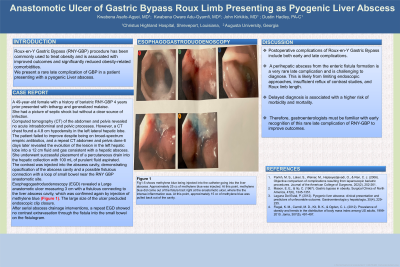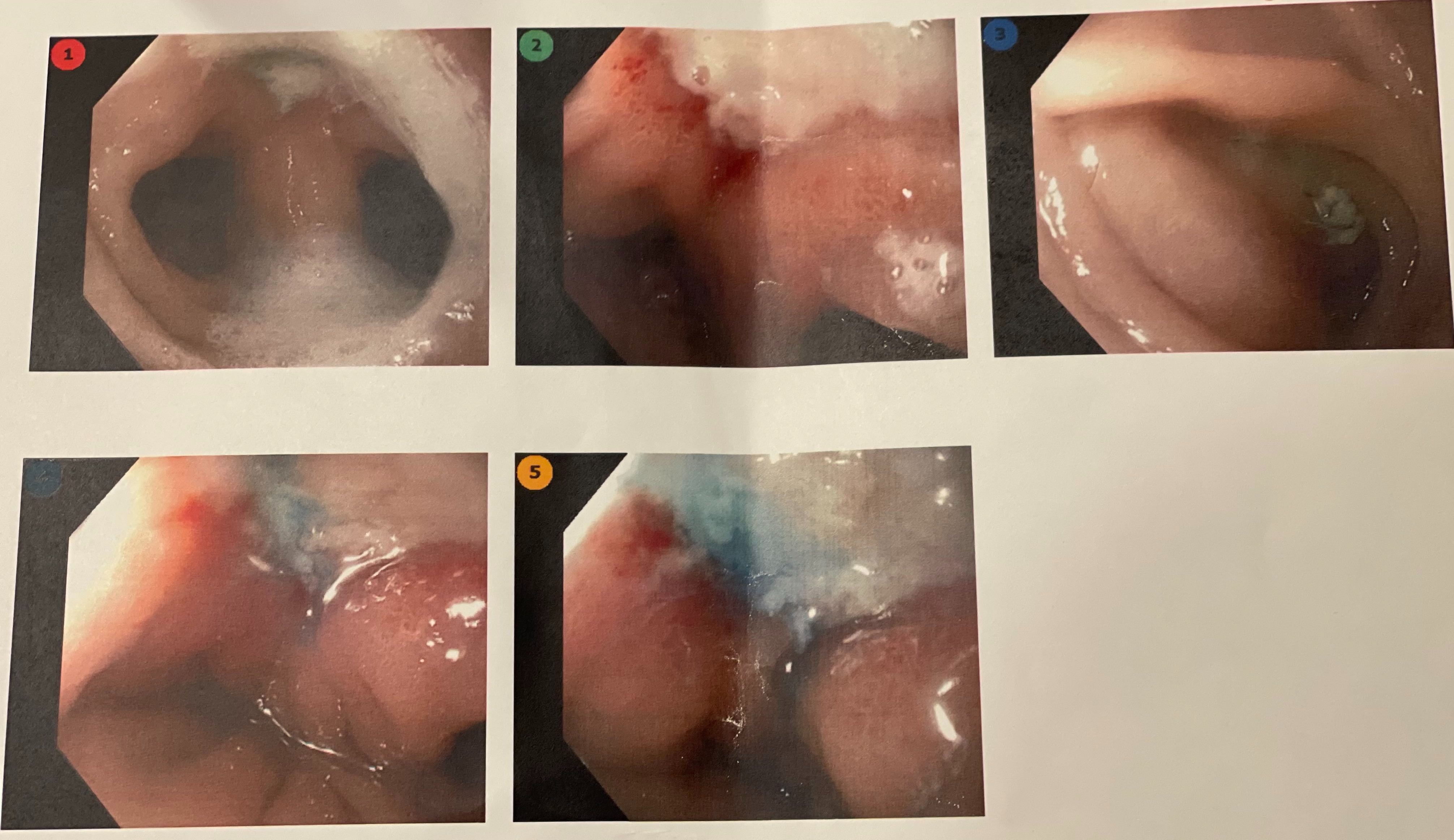Monday Poster Session
Category: Obesity
P2624 - Anastomotic Ulcer of Gastric Bypass Roux Limb Presenting as Pyogenic Liver Abscess
Monday, October 23, 2023
10:30 AM - 4:15 PM PT
Location: Exhibit Hall

Has Audio

Kwabena O. Asafo-Agyei, MD
Christus Highland Hospital
Shreveport, LA
Presenting Author(s)
Kwabena O. Asafo-Agyei, MD1, Kwabena O. Adu-Gyamfi, MD2, John Kirkikis, MD3, Dustin Hadley, PA-C4
1Christus Highland Hospital, Shreveport, LA; 2Medical College of Georgia at Augusta University, Augusta, GA; 3GastroIntestinal Specialists, Shreveport, LA; 4GastroIntestinal Specialist, Shreveport, LA
Introduction: Roux-en-Y Gastric Bypass (RNY-GBP) procedure has been commonly used to treat obesity and is associated with improved outcomes and significantly reduced obesity-related comorbidities.
We present a rare late complication of GBP in a patient presenting with a pyogenic Liver abscess.
Case Description/Methods: A 49-year-old female with a history of bariatric RNY-GBP 4 years prior presented with lethargy and generalized malaise.
She had a picture of septic shock but without a clear source of infection. Computed tomography (CT) of the abdomen and pelvis revealed no acute intraabdominal and pelvic processes. However, a CT chest found a 4.8 cm hypodensity in the left lateral hepatic lobe. The patient failed to improve despite being on broad-spectrum empiric antibiotics, and a repeat CT abdomen and pelvis done 6 days later revealed the evolution of the lesion in the left hepatic lobe into a 12 cm fluid and gas consistent with a hepatic abscess. She underwent successful placement of a percutaneous drain into the hepatic collection with 100 mL of purulent fluid aspirated.
Contrast was injected into the abscess cavity, demonstrated opacification of the abscess cavity and a possible fistulous connection with a loop of small bowel near the RNY GBP anastomotic site. Esophagogastroduodenoscopy (EGD) revealed a Large anastomotic ulcer measuring 3 cm with a fistulous connecting to the liver abscess cavity, which was confirmed again by injection of methylene blue (Figure 1). The large size of the ulcer precluded endoscopic clip closure. The liver abscess either resulted from the anastomotic ulcer perforating through the liver capsule or, less likely, a case of a primary liver abscess that ruptured in the small bowel through the anastomotic site ulcer. After serial abscess drainage interventions, a repeat EGD showed no contrast extravasation through the fistula into the small bowel on the fistulogram. The patient was subsequently discharged.
Discussion: Postoperative complications of Roux-en-Y Gastric Bypass include both early and late complications. A perihepatic abscess from the enteric fistula formation is a very rare late complication and is challenging to diagnose. This is likely from limiting endoscopic approaches, insufficient reflux of contrast studies, and Roux limb length.
Delayed diagnosis is associated with a higher risk of morbidity and mortality. Therefore, gastroenterologists must be familiar with early recognition of this rare late complication of RNY-GBP to improve outcomes.

Disclosures:
Kwabena O. Asafo-Agyei, MD1, Kwabena O. Adu-Gyamfi, MD2, John Kirkikis, MD3, Dustin Hadley, PA-C4. P2624 - Anastomotic Ulcer of Gastric Bypass Roux Limb Presenting as Pyogenic Liver Abscess, ACG 2023 Annual Scientific Meeting Abstracts. Vancouver, BC, Canada: American College of Gastroenterology.
1Christus Highland Hospital, Shreveport, LA; 2Medical College of Georgia at Augusta University, Augusta, GA; 3GastroIntestinal Specialists, Shreveport, LA; 4GastroIntestinal Specialist, Shreveport, LA
Introduction: Roux-en-Y Gastric Bypass (RNY-GBP) procedure has been commonly used to treat obesity and is associated with improved outcomes and significantly reduced obesity-related comorbidities.
We present a rare late complication of GBP in a patient presenting with a pyogenic Liver abscess.
Case Description/Methods: A 49-year-old female with a history of bariatric RNY-GBP 4 years prior presented with lethargy and generalized malaise.
She had a picture of septic shock but without a clear source of infection. Computed tomography (CT) of the abdomen and pelvis revealed no acute intraabdominal and pelvic processes. However, a CT chest found a 4.8 cm hypodensity in the left lateral hepatic lobe. The patient failed to improve despite being on broad-spectrum empiric antibiotics, and a repeat CT abdomen and pelvis done 6 days later revealed the evolution of the lesion in the left hepatic lobe into a 12 cm fluid and gas consistent with a hepatic abscess. She underwent successful placement of a percutaneous drain into the hepatic collection with 100 mL of purulent fluid aspirated.
Contrast was injected into the abscess cavity, demonstrated opacification of the abscess cavity and a possible fistulous connection with a loop of small bowel near the RNY GBP anastomotic site. Esophagogastroduodenoscopy (EGD) revealed a Large anastomotic ulcer measuring 3 cm with a fistulous connecting to the liver abscess cavity, which was confirmed again by injection of methylene blue (Figure 1). The large size of the ulcer precluded endoscopic clip closure. The liver abscess either resulted from the anastomotic ulcer perforating through the liver capsule or, less likely, a case of a primary liver abscess that ruptured in the small bowel through the anastomotic site ulcer. After serial abscess drainage interventions, a repeat EGD showed no contrast extravasation through the fistula into the small bowel on the fistulogram. The patient was subsequently discharged.
Discussion: Postoperative complications of Roux-en-Y Gastric Bypass include both early and late complications. A perihepatic abscess from the enteric fistula formation is a very rare late complication and is challenging to diagnose. This is likely from limiting endoscopic approaches, insufficient reflux of contrast studies, and Roux limb length.
Delayed diagnosis is associated with a higher risk of morbidity and mortality. Therefore, gastroenterologists must be familiar with early recognition of this rare late complication of RNY-GBP to improve outcomes.

Figure: Fig1-5 shows methylene blue been injected into the catheter going into the liver abscess. Approximate 25 cc of methylene blue was injected. At this point methylene blue was did come out of the fistula tract right at the anastomotic ulcer, where the the intense inflammation was.
At this point approximately 15 cc of methylene blue was pulled back out of the cavity.
At this point approximately 15 cc of methylene blue was pulled back out of the cavity.
Disclosures:
Kwabena Asafo-Agyei indicated no relevant financial relationships.
Kwabena Adu-Gyamfi indicated no relevant financial relationships.
John Kirkikis indicated no relevant financial relationships.
Dustin Hadley indicated no relevant financial relationships.
Kwabena O. Asafo-Agyei, MD1, Kwabena O. Adu-Gyamfi, MD2, John Kirkikis, MD3, Dustin Hadley, PA-C4. P2624 - Anastomotic Ulcer of Gastric Bypass Roux Limb Presenting as Pyogenic Liver Abscess, ACG 2023 Annual Scientific Meeting Abstracts. Vancouver, BC, Canada: American College of Gastroenterology.
